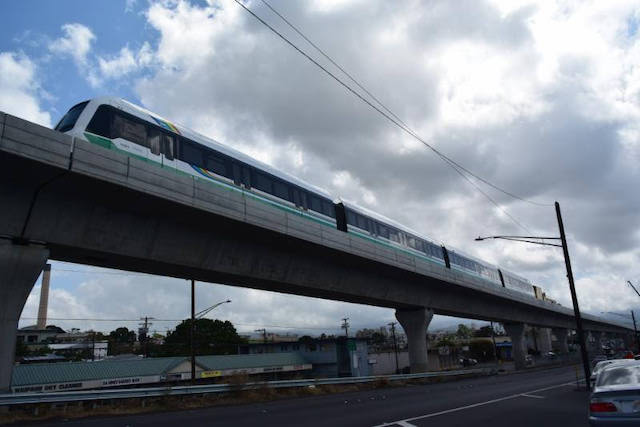
Another nearly empty train obstructs views in Honolulu. Photo by HART.
Honolulu Says It Underreported Riders
by Randall O’Toole, The Antiplanner July 14, 2023
The Honolulu Authority for Really-overpriced Transportation (HART) says that early reports of ridership on its new rail line only included people who paid full fares but not people who boarded with a transit pass. When all riders are counted, the rail line carried about 4,000 riders a day in its first week, about double its early reports.
Even 4,000 is a little short of the number that HART projected it would attract once the system is completed: 84,000 people a day. Unfortunately, the agency hasn’t published ridership estimates for the portion of the line that opened on June 30, but I doubt they would be anywhere near as low as 4,000 a day.
When the Antiplanner reported on the opening of the rail line last week, I calculated that the line’s capacity was 65,600 riders a day. That’s based on current schedules of six trains per hour for 13-1/2 hours a day and train capacities of 800 riders. Of course, some people could get off before the end of the line allowing others to get on. HART could also increase capacities by increasing frequencies.
So the rail line should be able handle 84,000 people a day if that many people ever want to ride it. I doubt that will ever happen.
HART projects operating costs will be about $100 million a year for the line that is currently open increasing to $160 million a year if and when it is ever completed. The city of Honolulu currently operates 106 bus routes at an operating cost under $210 million a year, so the $160 million cost of operating the full rail line represents a 76 percent increase in transit operating costs for just one new route.
If the line is ever completed, I suspect actual ridership will be less than half of projections or roughly 40,000 riders per weekday. At an average fare of $1 (which is more than the city collects from bus riders), that’s about $12 million a year or 7.5 percent of projected operating costs. The current truncated line, which serves the least-densely population portion of the entire route and reaches no real destination other than a football stadium, will probably never come close to half of the full line’s ridership. If it ever carries 10,000 riders a weekday, fare revenues will be about $3 million a year, or 3 percent of operating costs.
Based on this I suspect HART will more likely end up reducing frequencies rather than increasing them simply because it won’t be able to afford to continue to operate trains that are less than 10 percent full. Since the federal government won’t allow the city to simply stop running the trains without demanding that it repay the billions the FTA granted for construction, local taxpayers will be stuck paying the bills for this boondoggle for a long time.